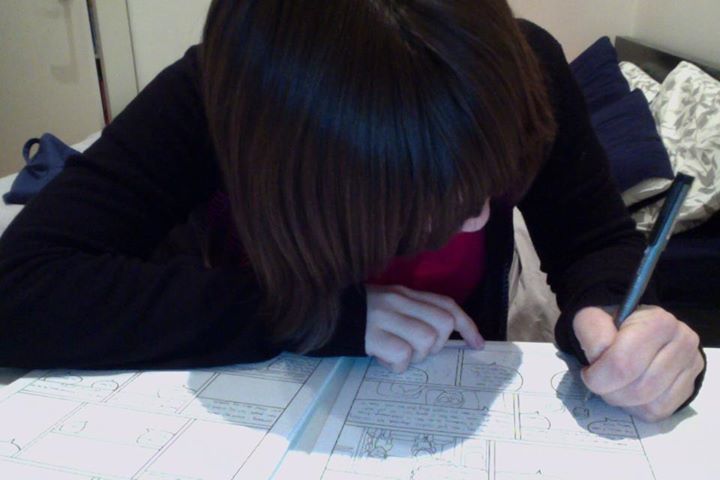Nate Cooper is an “edupreneur.” He teaches people how to do things.
Cooper believes in lifelong learning and he also believes that different forms of learning work for different types of people. So, he’s interested in teaching all kinds of ways. He does classes, workshops and one-to-one trainings that approach the same topics in different ways.
Now Cooper is trying a new way of teaching people: with a comic book.
Collaborating with webcomic artist Kim Gee (his former coworker from a stint at the Apple Store), Cooper is put together an adventure story where a young woman and her dog learn how to build their first website using HTML 5/CSS and WordPress.
Actually, we’re not sure if the dog learns any HTML.
The book is called Build Your Own Website: A Comic Guide to HTML, CSS, and WordPress. (Scroll down for some sample pages.) It was first funded via Kickstarter two years ago. It’s now available for pre-order and is due out later this week, on Sept. 6.
Cooper lives in Bed-Stuy, where he has been a denizen for six years. His collaborator lived in South Williamsburg at the beginning of the project but has since left Brooklyn. We first encountered Cooper at Brooklyn’s recent PechaKucha event.
###
We asked him some questions about his new project:

Nate Cooper. (Photo courtesy of Nate Cooper)
Why did you think that the comic book format would be one that would really make sense for helping people learn to code?
Part of my business is trying to make technology more approachable. Especially when it comes to coding, people in creative fields can become immediately turned off.
I hear a lot of analogies to math from students and clients. Even though I’m not trained as a designer, I’ve learned a lot about design by having to learn HTML and CSS. I feel like there’s a communication issue where right-brained people just shut-off when it comes to deciphering code.
The comic medium was a way to try to combat that by making the material approachable and fun. There’s a story in the comic that helps cement web concepts through analogy. I hope that makes it a book that would appeal to someone who’s struggled with getting into this stuff in the past.
Were there other comic book-based non-fiction works you especially admired?
Kim and I both talked at length about Scott McCloud books (Understanding Comics, Reinventing Comics) on comics as a medium. They’re both instructional and fun. I also have fond memories of Larry Gonick’s Cartoon History of the Universe series.
How did you find your collaborator?
Kim and I worked together at an Apple Store. I think I started reading her web comics then when she was still in school.
When I was leaving to go freelance, one of my biggest priorities was to spend more time writing. I asked Kim if she’d ever been commissioned before. I remember she was drawn to the idea of learning web concepts from a comic book. In a sense, she was my first reader and a version of her is actually the protagonist in the comic story. She’s since finished school, left Apple and now works as a designer for a startup.

Kim Gee, the book’s artist. (Photo courtesy of Kim Gee)
Was there a particular skill or part of the work where you felt that using a comic-based approach seemed to work exceptionally well?
I really liked all of the analogies. The story is based, in part, on an homage to The Wizard of Oz and that sort of fantasy setting allowed us to go a little bit more creative with analogies than I would normally get in a classroom. For example, the WordPress database is an actual physical library in the book.
Did you iterate on the script at all? For example, did you always plan to make a learner the center of its narrative? Or were there other approaches you played with?
Originally Kim and I had discussed having a comic version of me as a sort of narrator, the way that Scott McCloud puts himself into his comics. In the end, it really helped to have a more fantasy-like setting to really dig into the concepts we wanted to cover. So that’s where the sort of Wizard of Oz thing came from.
There’s subtle allusions to video games and other stuff in there too. It basically started with, “Here’s what I want to cover,” then, “How do we build an analogy in the story around that concept?”
I’ve been teaching this stuff in classes for the past three years and I have a pretty refined sense of what’s helpful to a beginner. Having the narrative helps to frame those topics and make them more entertaining in book format. It’s also (hopefully) an easy read. So yeah, the story evolved as I thought of new ways of representing things. There’s dragons and swords and space ships, a guru, a fairy and a fantasy city. But I hope those all serve to solidify the concepts of the book.
It’s also probably worth mentioning that each chapter has a followup text chapter that goes deeper into the concepts. There’s a glossary of terms. We really wanted to make something that people could use in a classroom setting but that they’d be just as likely to pick up just for the fun of it.
![Build Your Own Website]](https://technical.ly/brooklyn/wp-content/uploads/sites/4/2014/08/byow_074-075.png)
A look inside Build Your Own Website. See more here.
Join the conversation!
Find news, events, jobs and people who share your interests on Technical.ly's open community Slack
